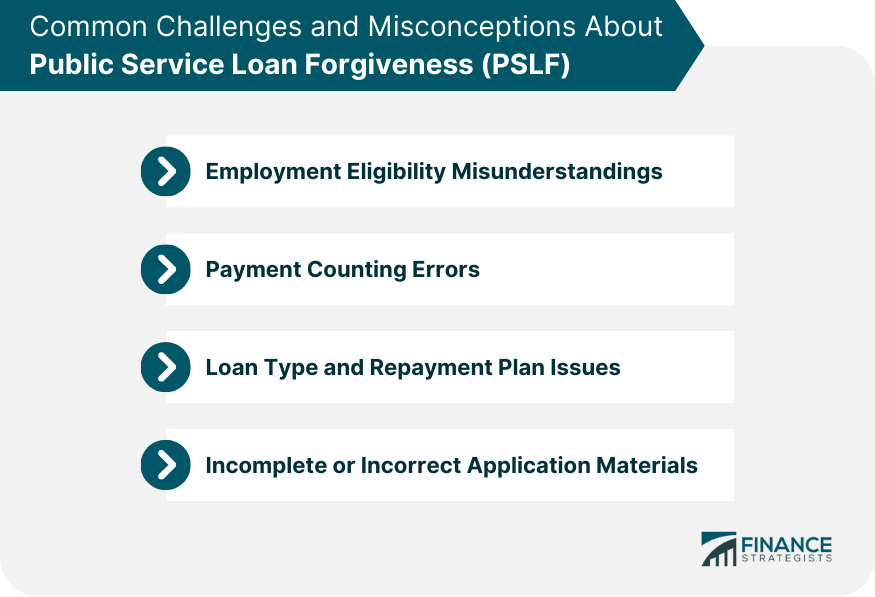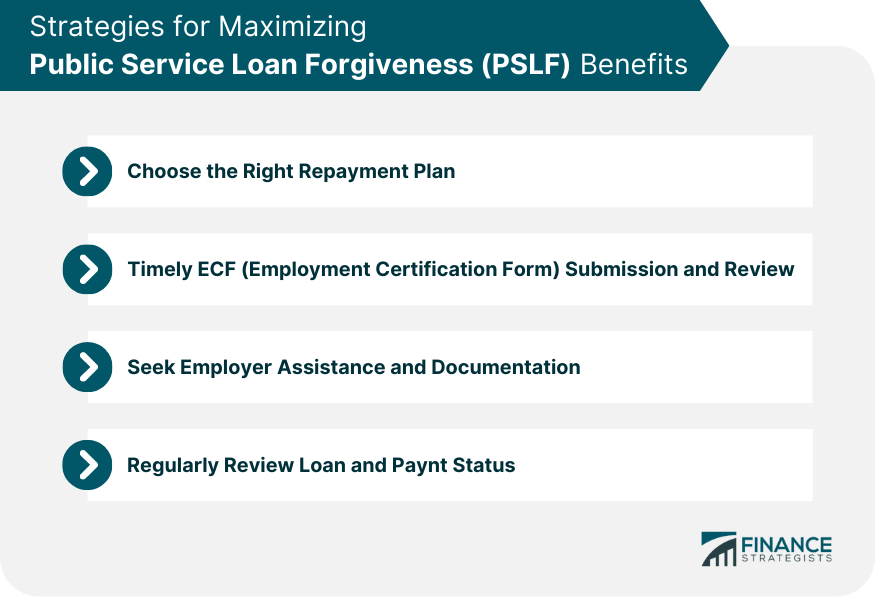The PSLF is a federal student loan forgiveness program in the United States. The program aims to forgive the remaining balance on eligible federal student loans for borrowers who work full-time in a qualifying public service job and make 120 qualifying monthly payments. The program was established in 2007 under the College Cost Reduction and Access Act to encourage individuals to pursue careers in public service and alleviate the burden of student loan debt for those working in certain public sector professions. By meeting the program requirements, borrowers can have their remaining loan balance forgiven after ten years of eligible employment and payments. Qualifying organizations include federal, state, local, or tribal governments and not-for-profit organizations that are tax-exempt under Section 501(c)(3) of the Internal Revenue Code. Additionally, some other types of not-for-profit organizations that are not tax-exempt may qualify if they provide certain public services, such as emergency management, public safety, or education. Full-time employment is generally defined as working at least 30 hours per week or meeting the employer's definition of full-time if it is higher. Borrowers who hold multiple part-time qualifying jobs can also qualify for PSLF if they work a combined average of at least 30 hours per week. Only federal Direct Loans are eligible for PSLF. These include Direct Subsidized Loans, Direct Unsubsidized Loans, Direct PLUS Loans, and Direct Consolidation Loans. Non-eligible loans, such as Federal Family Education Loans (FFEL) and Perkins Loans, can become eligible through consolidation into a Direct Consolidation Loan. However, it is essential to note that consolidating loans resets the payment count, so borrowers should carefully consider whether consolidation is the right choice based on their existing qualifying payments and remaining loan balance. The most common qualifying plans are income-driven repayment (IDR) plans, which include Income-Based Repayment (IBR), Pay As You Earn (PAYE), Revised Pay As You Earn (REPAYE), and Income-Contingent Repayment (ICR) plans. The Standard Repayment Plan, a 10-year repayment plan, also qualifies for PSLF. However, since PSLF requires 120 qualifying monthly payments, borrowers on the Standard Repayment Plan would have their loans paid off before receiving forgiveness. Therefore, borrowers seeking PSLF should enroll in an IDR plan. Qualifying payments are those made after October 1, 2007, and must be made for the full amount due by 15 days after the due date. Payments made during deferment, forbearance, or grace periods are not qualifying payments. It is important to note that the 120 qualifying payments do not need to be consecutive. If a borrower stops working in a qualifying job, their payment count will resume once they return to qualifying employment. Borrowers should submit the ECF annually, or whenever they change jobs, to confirm that their employment qualifies for PSLF. The ECF also allows the U.S. Department of Education to track borrowers' progress towards meeting the 120 qualifying monthly payments requirement. Submitting the ECF regularly helps borrowers avoid potential issues with eligibility and ensures that their payments are accurately counted towards PSLF. Borrowers should work with their employers to complete the ECF, which requires information about the organization and the borrower's employment status. The application requires documentation of qualifying employment, such as the ECFs submitted throughout the repayment process, and any additional supporting documents if requested. The U.S. Department of Education will review the application and notify the borrower of their decision. If approved, the remaining loan balance will be forgiven, and the borrower will not be required to make any further payments. If denied, borrowers should review their application materials and contact their loan servicer to address any errors or discrepancies. Individuals should regularly access their loan information through the Federal Student Aid website to review their payment history, remaining balance, and other relevant details. By closely monitoring qualifying payments and ensuring their ECFs are submitted and processed correctly, borrowers can address any issues arising during the repayment process and stay on track toward achieving loan forgiveness. Being employed full-time in a qualifying public service job is essential, but not all positions within qualifying organizations may be eligible. Borrowers should carefully review the PSLF eligibility requirements and work with their employers to ensure their job qualifies for the program. Borrowers should maintain accurate records of their payments and regularly submit ECFs to ensure their payment count is correct. If discrepancies are discovered, borrowers should contact their loan servicer to resolve the issue. Borrowers should review their loan types and repayment plans to ensure they meet PSLF requirements and consider consolidating non-eligible loans into a Direct Consolidation Loan if necessary. Borrowers should thoroughly review their PSLF application and ensure all required documentation is included and accurate before submission. For borrowers employed as teachers, the Teacher Loan Forgiveness Program is available. This program offers loan forgiveness of up to $17,500 for qualified teachers who work in low-income schools for at least five consecutive years. Borrowers enrolled in income-driven repayment (IDR) plan may qualify for loan forgiveness after 20 or 25 years of qualifying payments, depending on the specific IDR plan. However, unlike PSLF, any forgiven amount under IDR forgiveness may be considered taxable income. Several states offer loan forgiveness programs for borrowers in specific professions or regions. These programs may have unique eligibility requirements and benefits, so borrowers should research their state's offerings to determine if they qualify. Enrolling in an income-driven repayment plan is essential for borrowers seeking PSLF. These plans qualify for PSLF and lower monthly payments based on the borrower's income and family size. Choosing the right IDR plan can help borrowers manage their payments while working towards loan forgiveness. Submitting the Employment Certification Form annually or whenever a borrower changes jobs is crucial for staying on track for PSLF. It ensures that the borrower's employment and payment history are accurately recorded, reducing the likelihood of errors or discrepancies that could delay forgiveness. Working closely with employers can help borrowers navigate the PSLF process more smoothly. Employers can provide essential documentation, such as verifying the borrower's employment status and the organization's qualifying status, and offer guidance on meeting PSLF requirements. This includes monitoring their qualifying payment count, remaining loan balance, and any potential errors or discrepancies. Proactively addressing any issues can help borrowers stay on track toward loan forgiveness. The Public Service Loan Forgiveness program offers eligible borrowers the opportunity to have their federal student loans forgiven after ten years of full-time employment in government organizations or tax-exempt non-profit organizations and 120 qualifying monthly payments. Only federal Direct Loans are eligible, including Direct Subsidized Loans, Direct Unsubsidized Loans, Direct PLUS Loans, and Direct Consolidation Loans. Selecting the appropriate repayment plan is essential, with income-driven plans being the most common option for PSLF participants. Regular submission of the Employment Certification Form (ECF) is crucial to verify employment and payment history. It is important to address common challenges and misconceptions regarding employment eligibility, payment counting, loan types, and application materials. Exploring alternative loan forgiveness programs and strategies, such as the Teacher Loan Forgiveness Program or state-sponsored programs, can be beneficial. By choosing the right repayment plan, submitting the ECF in a timely manner, collaborating with employers, and proactively monitoring loan and payment status, borrowers can navigate the PSLF program successfully and maximize their benefits. What Is the Public Service Loan Forgiveness (PSLF)?
Eligibility Criteria for PSLF
Employment in Qualifying Public Service Jobs
Eligible Loan Types
Qualifying Repayment Plans
120 Qualifying Monthly Payments
Application Process for PSLF
Employment Certification Form (ECF)
Application Submission
Tracking Progress Towards Forgiveness

Common Challenges and Misconceptions About PSLF
Employment Eligibility Misunderstandings
Payment Counting Errors
Loan Type and Repayment Plan Issues
Incomplete or Incorrect Application Materials

Alternative Loan Forgiveness Programs
Teacher Loan Forgiveness Program
Income-Driven Repayment Forgiveness
State-Sponsored Loan Forgiveness Programs

Strategies for Maximizing PSLF Benefits
Choosing the Right Repayment Plan
Timely ECF Submission and Review
Seeking Employer Assistance and Documentation
Regularly Reviewing Loan and Payment Status

Conclusion
Public Service Loan Forgiveness (PSLF) FAQs
The Public Service Loan Forgiveness (PSLF) program is a U.S. government initiative that forgives the remaining balance of student loans for borrowers who have made 120 qualifying payments while working full-time for a qualifying employer, typically a government or non-profit organization.
To be eligible for the Public Service Loan Forgiveness (PSLF) program, you must be a borrower of a direct loan, be employed full-time by a U.S. federal, state, local, or tribal government or not-for-profit organization, have made 120 qualifying payments under a qualifying repayment plan while working full-time for a qualifying employer, and have submitted the PSLF form to the U.S. Department of Education.
To apply for the Public Service Loan Forgiveness (PSLF) program, you must submit the PSLF form to the U.S. Department of Education after you have made 120 qualifying payments. It's also recommended to submit the Employment Certification Form annually or whenever you change employers to ensure you're on track.
Only Direct Loans are eligible for the Public Service Loan Forgiveness (PSLF) program. These include Direct Subsidized Loans, Direct Unsubsidized Loans, Direct PLUS Loans, and Direct Consolidation Loans. Other types of federal student loans, like Federal Family Education Loan (FFEL) Program Loans or Perkins Loans, can become eligible if they are consolidated into a Direct Consolidation Loan.
If you change jobs while pursuing the Public Service Loan Forgiveness (PSLF) program, your new employer must also be a qualifying employer for your payments to continue to count towards the 120 required payments. If your new employer does not qualify, your payments will not count towards PSLF, but they may resume counting if you later return to work for a qualifying employer.
True Tamplin is a published author, public speaker, CEO of UpDigital, and founder of Finance Strategists.
True is a Certified Educator in Personal Finance (CEPF®), author of The Handy Financial Ratios Guide, a member of the Society for Advancing Business Editing and Writing, contributes to his financial education site, Finance Strategists, and has spoken to various financial communities such as the CFA Institute, as well as university students like his Alma mater, Biola University, where he received a bachelor of science in business and data analytics.
To learn more about True, visit his personal website or view his author profiles on Amazon, Nasdaq and Forbes.











